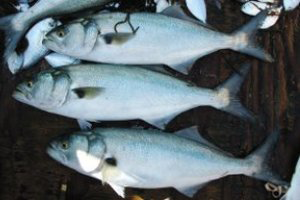The abundance of juvenile ("snapper") bluefish in coastal waters depends in part on currents that transport the young from the offshore spawning areas to critical feeding areas in bays and estuaries.
Photo Credit: Joe Kunkel
Pomatomus saltatrix
Common Name: bluefish
Animal Guild: Fish
Class > Order > Family: Teleostei > Perciformes > Pomatomidae
What does the species look like?
Bluefish have a sea green or bluish green back and silvery belly. The pectoral fins, located near the gill cover, have a black blotch at the base. There are two dorsal fins, located on the back, and one anal fin, located on the underside of the body just forward of the tail fin and used for stabilization while swimming. The first dorsal fin is spiny and can fold back into a groove. The ventral fins are well forward of the dorsals and are located underneath the pectorals. The tail fin is broad and forked. The lower jaw protrudes slightly beyond the upper jaw of the large mouth. The upper and lower jaws are lined with a series of stout, conical caninelike teeth. Maximum length is about 3.5 feet (a little more than 1 meter).
Where is the species found?
States & Provinces
AL, CT, DE, FL, GA, LA, MA, MD, ME, MS, NC, NH, NJ, NY, RI, SC, TX, VA
Distribution
This species ranges in the western North Atlantic from Nova Scotia south to Argentina (including Bermuda and the Gulf of Mexico), but it is rare between southern Florida and northern South America. It also occurs in other warm seas worldwide but not in the eastern Pacific Ocean.
Within the Middle Atlantic region off eastern North America bluefish occur in large bays and estuaries as well as across the entire continental shelf. Adults occur in bays and estuaries primarily in the warmest summer months. Juvenile stages have been recorded from all estuaries surveyed within the Middle Atlantic region, but eggs and larvae occur in oceanic waters. [Source: Shepherd and Packard 2006]
General Phenology and Life History
Bluefish travel in schools of like-sized individuals and undertake seasonal migrations. Along the U.S. Atlantic coast they generally move north in spring-summer to centers of abundance near New York and southern New England and south in autumn-winter to the waters as far as southeastern Florida. Spawning occurs offshore in spring-summer (possibly in fall off Florida). Eggs hatch in about 2 days at 18-22°C. Juveniles move into estuaries in spring or summer (earlier in the south than in the north) and move out to sea in fall as temperatures decline. [Source: Shepherd and Packard 2006]
Which phenophases should I observe?
Do you see/hear...?
Activity
Adults in saltwater More...
For abundance, enter the number of individual animals observed in this phenophase.
Adults feeding For abundance, enter the number of individual animals observed in this phenophase.
Development
Juveniles in saltwater For abundance, enter the number of individual animals observed in this phenophase.
Dead or dying adults For abundance, enter the number of individual animals observed in this phenophase.
Method
Individuals on a hook For abundance, enter the number of individual animals observed in this phenophase.
Individuals in a net For abundance, enter the number of individual animals observed in this phenophase.
What do these phenophases look like?
There is currently no photoguide available for this species. If you'd like help us create one, use the guidance document and species template provided here . Then send it via email to education@usanpn.org when it is complete.
